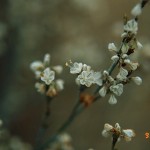Wright's Buckwheat , Wright Buckwheat, Wild Buckwheat
Eriogonum wrightii
Polygonaceae
Description
Wright’s Buckwheat (aka Wild Buckwheat) is a low, highly branched, perennial shrub in the Buckwheat (Polygonaceae) family that grows from a robust taproot and has a reddish woody base. It resembles few other species. The Flora of North America recognizes nine varieties which are all in cultivation. The variety in West Texas is E. wrightii var wrightii. Its defining characteristic is white tomentose (short, soft, matted, woolly hairs) stems. While it can grow to 40 inches or 100 cm, it may appear as a short (< 30 cm) matted shrub. Its stems can be hairless, sparsely to moderately tomentose, or lanate (densely covered with long, tangled hairs). The oblanceolate to elliptical leaves are about 1 inch long and clustered in fascicles at the base; going up the stem, they are scattered, narrow, and inconspicuous. The leaves can be up to 30 mm long by 10 mm wide and colored grayish, greenish, or reddish. Leaf surfaces are usually tomentose but sometimes only slightly hairy. When in flower (August to October), the plant appears as a white bouquet that turns reddish-orange in cool weather. Americasouthwest.net describes the inflorescence as “an open cluster, containing long, straight branches, along which are relatively well-separated involucres, each containing around four flowers”. The flowers are composed of six white to pink or rose petals, and exhibit exerted stamens, reddish bracts, and red stripes on the petal bottoms.Habitat
The plant generally grows on dry rocky slopes and foothills in the low mountains of West Texas. It has been recorded in the Trans- Pecos, Edwards Plateau, and Plains regions. It is found in association with Juniper and Sagebrush species.Toxic Agent
The toxin involved in buckwheat poisoning is a photodynamic agent. The animal absorbs this substance directly from its digestive tract (primary photosensitization) and can transfer it to calves through the milk. Once this process occurs, the animal becomes hypersensitive to sunlight. John Kinsbury writes in Poisonous Plants of the United States and Canada, “In this hemisphere, outbreaks of buckwheat photosensitization are rare.”Signs of Livestock Ingestion
Signs of photosensitization include: • Reddening of light-colored skin, especially thin-skinned areas and those having thin or no hair, such as the muzzle, udder, and vulva. • Skin inflammation followed by swelling, blisters, fluid seepage and usually sloughing of the skin. • For dark animals, the skin is not blistered or sloughed, but it usually becomes thickened and crusted.Management Strategies
Animals with primary photosensitization (as compared to hepatogenous photosensitization) seldom die if proper precautions are taken. As soon as clinical signs begin, place affected animals in the shade with feed and water. Painting or spraying the affected skin with methylene blue solution or some other nontoxic dye helps protect the areas from further sun exposure. Move unaffected animals to a new pasture, free of the plant causing the photosensitization.Images
Plant Characteristics
Flower Color: Pink, Red, White
Seed Type: Non-Encapsulated
Duration: Perennial
Stem Texture: Hairless/Smooth
Growth Habit: Shrub (Woody)
Leaf Shape
 : Simple with Pinnate or Parallel Venation
: Simple with Pinnate or Parallel Venation
Season: Warm
Distribution
 : 04 - Blackland Prairies, 10 - Trans-Pecos
: 04 - Blackland Prairies, 10 - Trans-Pecos
Distributions
Distribution refers to the ecological region in Texas that a plant has been found. You can also view a clickable map.
Book: Toxic Plants of Texas (B-6105)
Collection: Toxics, Wild Flowers
Livestock Affected: Cattle
Livestock Signs: Photosensitization






